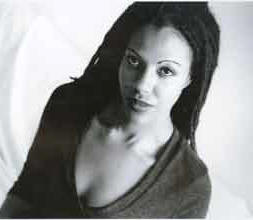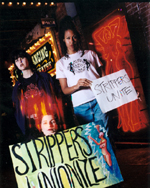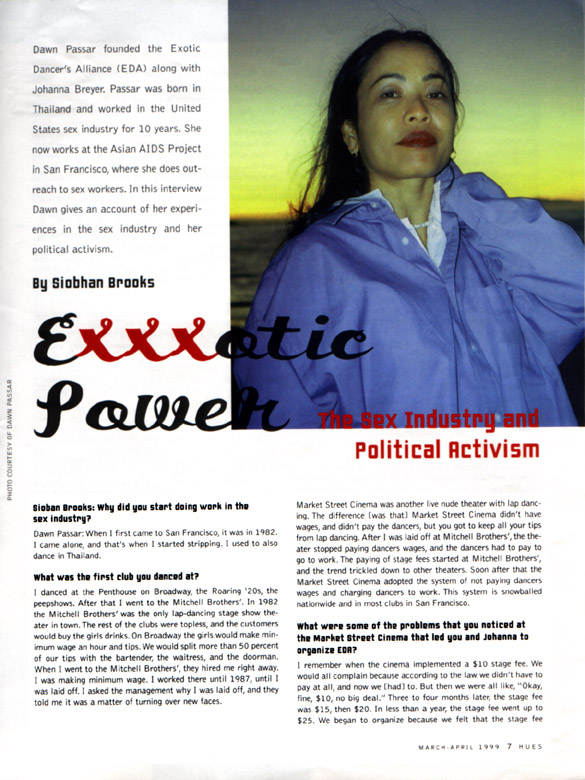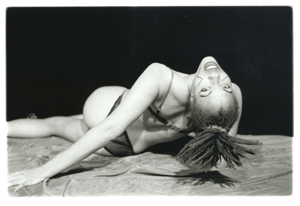 Siobhan
Brooks
Siobhan
BrooksExotic Dancer Organizer,
Queer Black Feminist.
Ph.D. Candidate
FemmeNoir
A Web Portal For Lesbians Of Color
 Siobhan
Brooks
Siobhan
BrooksWhen people think of pornography and the
sex industry in general, they are usually thinking about white
women with their legs open in the spread of a magazine. This
image largely informs the pornography debate, which consist
mostly of middle class white women debating about whether
pornography is oppressive (the view that Andrea Dworkin and
Catherine McKinnon hold) or liberating (the “sex positive”
viewpoint that white feminist like Carol Queen and Annie
Sprinkle hold). This debate does not deal with Women of Color in
the sex industry, whom are made invisible by both of these
feminists’ camps.
When many women of color feminists discuss the sex industry in
relation to women of color, they tend to only focus on the
oppressive aspects of it fueled by racial stereotypes about
women of color, especially Black female sexuality, which can
easily fall into the category of blaming the victim for being in
the sex industry, and in their view furthering these
stereotypes. What feminists of color in this camp fail to
realize is that the racial stereotypes about us were formed
prior to the creation of pornography and music videos. They were
formed during slavery and colonization and exist to justify
European colonization, our labor exploitation, and our being
tracked into low-wage service jobs like being nannies, underpaid
farm workers, maids, janitors, and lower sectors of the sex
industry. The enforced breeding of Black people during slavery
was about creating an exploited labor force---we were never paid
for our sexual labor.
 The
racial stereotypes and the history of labor exploitation combine
to regulate us into the most undesirable elements of sex work.
Women of color work in the seedier strip clubs, not the high
class ones. We do outdoor prostitution more often then indoor
prostitution, are put more at risk for HIV and AIDS, do lower
paid pornography, and prostitutes of color are arrested by the
police at higher rates than white prostitutes. People of color
are coming from a non-human status verses white people who are
coming from a human status. This is social Darwinism,
historically people of color were viewed as primitive during
European modernity, and were often featured as freaks in zoos
and put on display for white people---such as Saartjie Baartman,
The Hottentot Venus is an example of this. White women were not
objectified this way.
The
racial stereotypes and the history of labor exploitation combine
to regulate us into the most undesirable elements of sex work.
Women of color work in the seedier strip clubs, not the high
class ones. We do outdoor prostitution more often then indoor
prostitution, are put more at risk for HIV and AIDS, do lower
paid pornography, and prostitutes of color are arrested by the
police at higher rates than white prostitutes. People of color
are coming from a non-human status verses white people who are
coming from a human status. This is social Darwinism,
historically people of color were viewed as primitive during
European modernity, and were often featured as freaks in zoos
and put on display for white people---such as Saartjie Baartman,
The Hottentot Venus is an example of this. White women were not
objectified this way.
The focus of white women in porn and advertising (while their
critiques of sexism are valid) serves to reproduce a capitalist
white nation-state and justify racism and wage inequality
against people of color, by the fact that we are not viewed as
sexually attractive. We are not ever seen as sex symbols. Many
women of color were sterilized, and people of color’s bodies
were often used in medical experiments, men of color were
lynched upon charges of raping white women, women of color are
seen as more sexually ‘exotic’ in relation to white women, thus
we are underpaid in the sex industry, as in other service
sectors.
From her Keynote Speech entitled, “Beyond Objectivity: Racism
and Wage Inequality Within the Exotic Dancing Industry”
delivered at Colorado University at Boulder at the International
Women’s Week for the conference entitled, “The Business of
Bodies; Women and the Global Sex Market” 2002.
 Siobhan
Brooks was born in 1972 and grew up in the Sunnydale Housing
Projects of San Francisco. Her mother, Aldean Brooks, who is now
deceased, raised her. Siobhan started school at eight. She
succeeded well in school, in spite of institutionalized racist
incidents, like when she was placed in an ESL class in the fifth
grade, even though she only spoke English at home, and went to
San Francisco State University, where she majored in Women’s
Studies. It was in women’s studies that she learned about the
pornography debate, and learned that many of her friends, who
were mostly white, in women studies were working in the sex
industry to support their way through college.
Siobhan
Brooks was born in 1972 and grew up in the Sunnydale Housing
Projects of San Francisco. Her mother, Aldean Brooks, who is now
deceased, raised her. Siobhan started school at eight. She
succeeded well in school, in spite of institutionalized racist
incidents, like when she was placed in an ESL class in the fifth
grade, even though she only spoke English at home, and went to
San Francisco State University, where she majored in Women’s
Studies. It was in women’s studies that she learned about the
pornography debate, and learned that many of her friends, who
were mostly white, in women studies were working in the sex
industry to support their way through college.
Many of them worked at the Lusty Lady Theater, a famous peep
show in the North Beach area known for its feminist politics
(displayed by the hiring of former dancers as managers as
opposed to men). Siobhan was a phone sex operator for a year,
and a nude model for art classes before working at the Lusty
Lady. She liked exploring her erotic side, and didn’t have a
problem being nude in front of people, and decided to audition
at the Lusty Lady to support herself while at State, like her
classmates. But she knew that race played an issue in the sex
industry and wondered if she would be hired. Josephine, a former
Black dancer, hired her after watching her audition---she was
one out of four Black dancers that worked there out of seventy
dancers; in sum ten were women of color.
After six months of working at the Lusty Lady, Siobhan noticed
some problems. One of the main problems was that Black dancers
were not scheduled to work in a more lucrative part of the club
called the Private Pleasures booth. This was a separate area of
the club, where dancers are separated by glass from the
customer, like on the main stage. The cost was $5.00 for three
minutes (and is now $10 for three minutes). A dancer could make
up to $60 per hour, a booth shift was divided into two hours on
stage, and two hours of booth with a thirty minute break in
between. The club kept seventy percent and the dancer kept
thirty percent, now dancers keep a higher percentage. If a
dancer wanted to work in booth, she had to tell a manger, so she
could be trained with how to negotiate higher prices with
customers for things like dildo shows (if one chooses to do
them), deal with rude customers, and clean the booth with
vinegar and rubbing alcohol. After a few months of being on
stage (which takes bills and quarters) where the wages were $11
per hour to the top wage of $24, Siobhan wanted to try out the
booth.
Josephine trained her and she did a booth shift for that week,
but was not scheduled for the following week. She noticed that
her white and non-Black coworkers worked in booth twice or more
a week. She thought maybe her performance was not as solid,
since she was new, but began to notice that the other Black
women never worked in booth, either. She confirmed this with the
other Black women and some white dancers that it was very rare
that a Black woman worked in booth. She asked Josephine about
this unwritten rule and was told by Josephine that the reason
why they don’t allow Black women to work in booth because the
company felt that white men would rather pay a quarter to see
Black women on stage than $5.00 for three minutes in booth, she
also said that when she use to dance and work booth, two white
men came up to her and said she looked like a monkey in a cage.
 Siobhan
at first didn’t question this, but felt angry and hurt that she
was prevented from working the booth. A few weeks later, her
coworker, Julia Query (co-producer of Live, Nude, Girls, Unite!)
wrote a petition directed at the general manger, June Cade that
dancers who worked in booth should get paid a higher percentage.
The dancers signed this petition, which made Siobhan angry
because if it were to go through, it would widen the wage gap
between Black dancers, and dancers that did booth. So, she wrote
her own petition, also directed at June, stating that Black
dancers should be allowed to work booth more often. While
Julia’s petition didn’t upset June, and she was willing to work
with the white dancers to work something out, Siobhan was
reprimanded by June and Josephine for jumping to conclusions
about the policy being racist, and if she wanted to work in
booth, all she had to do was ask. After a meeting with the Black
dancers and management, it was decided that Black dancers would
be rotated throughout the week. But after her petition, the
management held a general meeting about banning political
literature in the dressing room.
Siobhan
at first didn’t question this, but felt angry and hurt that she
was prevented from working the booth. A few weeks later, her
coworker, Julia Query (co-producer of Live, Nude, Girls, Unite!)
wrote a petition directed at the general manger, June Cade that
dancers who worked in booth should get paid a higher percentage.
The dancers signed this petition, which made Siobhan angry
because if it were to go through, it would widen the wage gap
between Black dancers, and dancers that did booth. So, she wrote
her own petition, also directed at June, stating that Black
dancers should be allowed to work booth more often. While
Julia’s petition didn’t upset June, and she was willing to work
with the white dancers to work something out, Siobhan was
reprimanded by June and Josephine for jumping to conclusions
about the policy being racist, and if she wanted to work in
booth, all she had to do was ask. After a meeting with the Black
dancers and management, it was decided that Black dancers would
be rotated throughout the week. But after her petition, the
management held a general meeting about banning political
literature in the dressing room.
A few months later the white dancers complained to June about
being videotaped by customers through windows on stage called
“one-way” meaning that a dancer could only see her own
reflection and not the customer. Customers were videotaping
dancers, which turned into a security issue for not only the
dancers, but also the men who worked at the club, who often had
a hard time catching the customers. June refused to remove the
windows because she thought they were lucrative for attracting
the “shy” customer. The dancers began working with a group of
former dancers who helped dancers with legal issues. They called
a non-profit group, The Exotic Dancer’s Alliance
http://www.eda-sf.org/. They
also worked with the Service Employees International Union Local
790. Dancers decided they wanted a union and quickly took action
to have dancers and support staff, vote for union
representation. Siobhan was very involved in this process, but
angered that her white co-workers didn’t see the racial issue as
the first indicator of labor abuses. She remembered how white
men often waved her out of view, so she felt the videotaping
issue was not the first thing on the agenda for the women of
color at the Lusty Lady, but job security.
In six months the Lusty Lady unionized with SEIU Local 790 in
the summer of 1996 becoming the first club in the United States
to successfully unionize. Siobhan filed a racial discrimination
complaint with the EEOC and the club hired more women of color
than ever before in its seventeen-year history history. She has
gone on to lecture and educate people about the specific issues
affecting sex workers of color, such as globalization, welfare
reform, immigration, anti-transgender policies, anti-affirmative
action legislature, and racism within the industry, regarding
working conditions of sex workers of color. “Clubs where women
of color work are usually in worse condition than mostly white
clubs.” She makes connections with the historical labor
exploitation of people of color and how the positioning of
people of color in the sex industry is an extension of that. She
also connects the intersection of queerness within the sex
industry, stating, “Queer
 people
of color are excluded from jobs within the ‘straight’ realm.
Lesbians and prostitutes are both groups that are outside of the
role of women in a male dominated society. Also, women make less
than men, so the sex industry does give them the opportunity to
make wages they would not make in other types of work.
Transgenders are largely kept out of the labor force, and
regulated to lower sectors of the sex industry, and jobs in
general. The sex industry is also how a lot of working class
transgender people of color pay for their transitions. I am
always surprised when I meet queer people of color, and they
have little knowledge about the sex industry, even though they
often know people who have worked in it. I came into my
queerness in the sex industry, it was normal to be queer there,
but I was disappointed when queer women of color outside of the
sex industry felt that somehow sex workers were ‘selling out’ to
men. The liberation of sex workers can only strengthen our
communities. If we want to work in the sex industry, we should
be supported. I don’t want the finger pointed at me; I want the
fist to be thrown up for me.” She wants to educate more people
of color about the sex industry, instead of lecturing within the
white dominated sex workers’ movement. Like many white dominated
movements, the sex workers’ movement can be very racist and
classist. For example, she would be appalled at the racist films
that Annie Sprinkle would show during sex worker film festivals
that had blatant racist and Orientalist themes, which the
audience loved. “I want to put a Colored face to the sex workers
movement.”
people
of color are excluded from jobs within the ‘straight’ realm.
Lesbians and prostitutes are both groups that are outside of the
role of women in a male dominated society. Also, women make less
than men, so the sex industry does give them the opportunity to
make wages they would not make in other types of work.
Transgenders are largely kept out of the labor force, and
regulated to lower sectors of the sex industry, and jobs in
general. The sex industry is also how a lot of working class
transgender people of color pay for their transitions. I am
always surprised when I meet queer people of color, and they
have little knowledge about the sex industry, even though they
often know people who have worked in it. I came into my
queerness in the sex industry, it was normal to be queer there,
but I was disappointed when queer women of color outside of the
sex industry felt that somehow sex workers were ‘selling out’ to
men. The liberation of sex workers can only strengthen our
communities. If we want to work in the sex industry, we should
be supported. I don’t want the finger pointed at me; I want the
fist to be thrown up for me.” She wants to educate more people
of color about the sex industry, instead of lecturing within the
white dominated sex workers’ movement. Like many white dominated
movements, the sex workers’ movement can be very racist and
classist. For example, she would be appalled at the racist films
that Annie Sprinkle would show during sex worker film festivals
that had blatant racist and Orientalist themes, which the
audience loved. “I want to put a Colored face to the sex workers
movement.”
Siobhan is also a freelance model and has modeled for
photographers, like Michele Serchuk for the March 2001 issue of
On Our Backs, and is a model for the film advertisement of Live,
Nude, Girls, Unite, which appeared in the September 2001 issue
of Playboy. “I want to create a space for us as people of color
to explore our sexuality outside of racist paradigms.”
She has lectured at San Francisco State University, Yale, U.C.
Berkeley, Colorado University at Boulder, Barnard, CUNY, and
Rutgers. She is in the documentary, Live, Nude, Girls, Unite!
www.livenudegirlsunite.com produced by Julia Query and Vicky
Funari about the unionization of the Lusty Lady. She is a writer
and has published in anthologies such as, Feminism and
Anti-Racism: International Struggles for Justice co-edited by
France Winddance Twine and Kathleen Blee (NYU Press, 2001),
Revolutionary Voices edited by Amy Sonnie (Alyson Press, 2000),
Sex and Singles Girls edited by Lee Damsky (Seal Press, 2000),
and Colonize This: Young Women of Color on Today's Feminism
co-edited by Daisy Hernandez and Bushra Rehman (Seal Press,
2002), and the magazines Z, Third Force, where she wrote an
article about her activism at the Lusty Lady. She was also
published in Bitch Magazine. She is currently studying for her
Ph.D. at the New School for Social Research in Sociology. She
has received financial support from organizations, such as, the
Third Wave Foundation. She is working on an interview book about
sex workers of color called, “Dancing Shadows: Interviews with
Men and Women of Color Sex Workers,” and is currently looking
for a publisher. She interviewed Angela Y. Davis for the U.C.
Hastings Law journal about race, feminism, and sex work, which
is now up on the EDA website
http://www.eda-sf.org/pages/angeladavis.html. She has
also interviewed sex worker activist like Dawn Passar,
co-founder of the EDA
http://www.eda-sf.org/submissions/interviewdp.html, and
Gloria Lockett, COYOTE member,
http://www.spectator.net/1155/pages/1155_lockett.html.
She has also appeared in the 80's, goth-punk porn film by
Christopher Lee and J Zapata, "Sex Flesh in Blood", which was
shown in the The 2nd San Francisco Sex Worker Film and Video
Festival and Trannyfest.
Links to other Articles:
Siobhan Brooks – by Clint Page Henderson
http://www.journalism.sfsu.edu/www/pubs/gater/spring96/feb22/24.html
Letter to the editor: Response to Above Article by Siobhan
Brooks
http://www.journalism.sfsu.edu/www/pubs/gater/spring96/mar7/09.html
Comes Naturally: Live Nude Girls Unite!
Julia Query's Important New Film
Column by David Steinberg Photographs courtesy First Run
Features
http://www.spectator.net/1151/pages/1151_steinberg.html
Whores and Other Memoirists
http://www.metroactive.com/papers/sfmetro/05.18.98/books1-9818.html
Stripping Away the Beauty Myth, By Siobahn Brooks
http://anet.net/~scorpio/Moondance/Nonfiction/stripping.htm
Links:
[PDF]
NAKED FEMINISM: THE UNIONIZATION OF THE ADULT ENTERTAINMENT
...
File Format:
PDF/Adobe Acrobat -
View as HTML
... the club subject to a class-action suit discussed
herein, Interview by Siobhan Brooks
with Dawn Passar, Co-Founder of the Exotic Dancers' Alliance.
Other Noteworthy Films:
Straight for the Money
by Hima B. - Interviews with
lesbian sex workers. (60 mins.)
Another major presentation was Straight For The Money, "curated"
by Hima B.; this film featured interviews with lesbian
prostitutes and dancers concerning their feelings about their
work performing for straight men and women.
Presented from a pro-sex worker point of view, Straight For The
Money: Interviews with Queer Sex Workers is about the
observations and experiences of eight lesbian and bisexual women
who work as lapdancers, peepshow dancers, prostitutes in San
Francisco. Bold and articulate, these women discuss the impact
of sex work on their personal lives, the feminist politics of
sex work, and the need for a broader understanding of a greatly
stigmatized and stereotyped occupation. Featured at
International Lesbian and Gay Festivals around the world; at
Toronto Whore Culture Festival; from India to America: New
Directions in Indian-American Film and Video, Whitney Museum NY;
Paris Lesbian Film Festival); Bombay, India, New Delhi and
Whitney Biennial.
Live Nude Girls Unite!
by Vicky Funari and Julia Query - Chanting "Two four six eight.
Don't go in to masturbate", peep show dancers successfully
organize, unionize and negotiate a contract. (70 mins.)
Live Nude Girls Unite, documents, the successful campaign to
organize strippers into a union in San Francisco and one
dancer's "coming out" as a sex worker to her mother.
For Speaking Engagements Contact:
David S. Neale, Owner, Resource Manager
Black Lavender Resources
Phone: 301-702-2009
Email:
BlackLavender1@aol.com
To Contact Siobhan Brooks Directly:
Email:
Articles
Interview With Tyra a transgender sex worker
Lusty
Ladies are Feisty Ladies
Copyright 1997 by Christine Beatty
Stripping Away the Beauty Myth
By Siobahn Brooks
HUES - Hear Us Emerging Sisters
Article by Siobhan Brooks
Working the Streets Gloria Lockett's Story
Interviewed by Siobhan Brooks
Whores and Other Memoirists
Adventurers in the Skin Trade: Six sex-industry
workers and one witch give encouraging advice to a small crowd
of strippers on how to break into the old boys' network of
publishing.
A writing conference coaches strippers on turning their sex-work
experience into a career in publishing
On Our Backs: The Best Erotic Fiction
Release date: 2001 • 248 pages • Softcover • 1-55583-652-6
Home